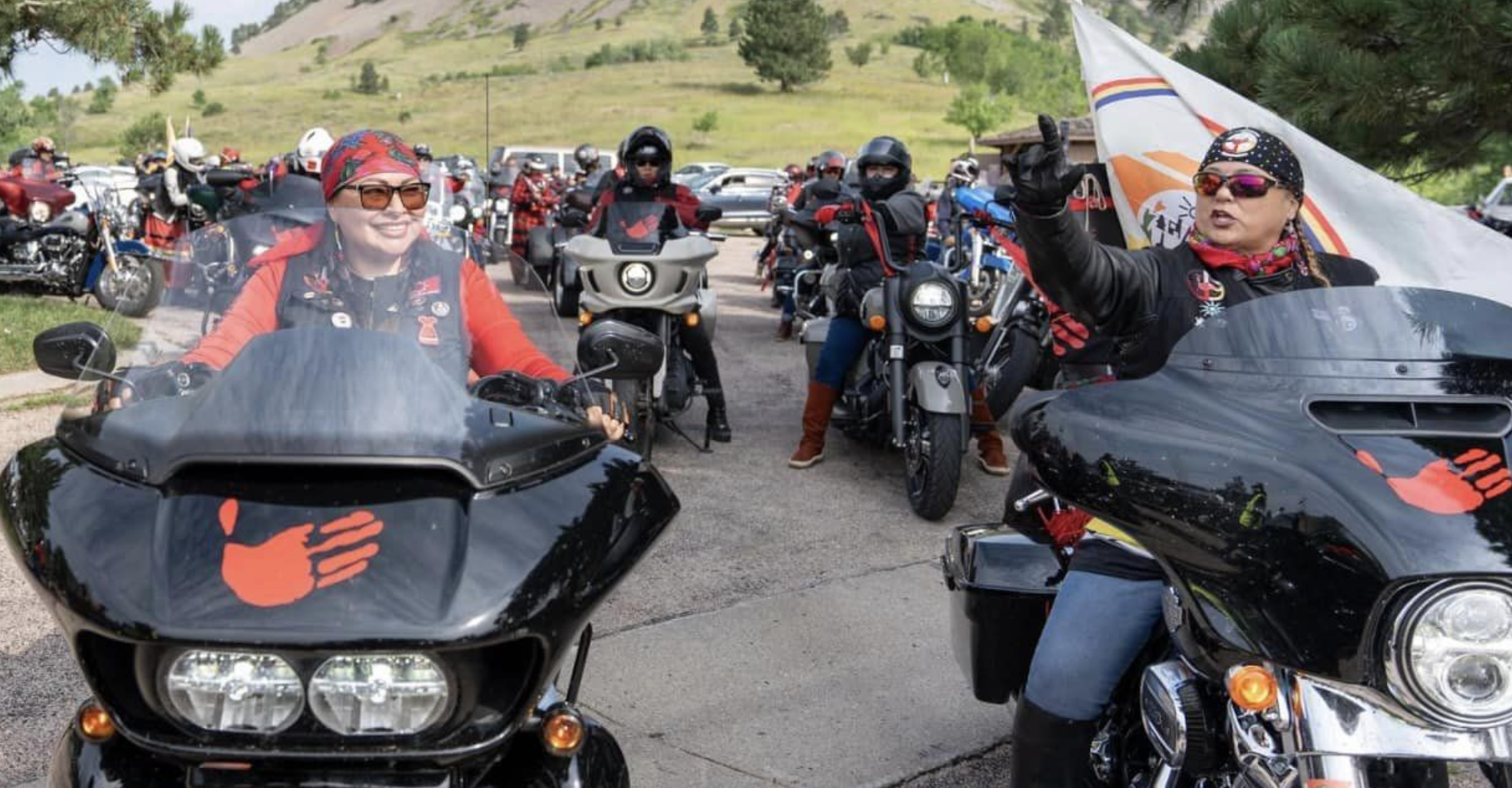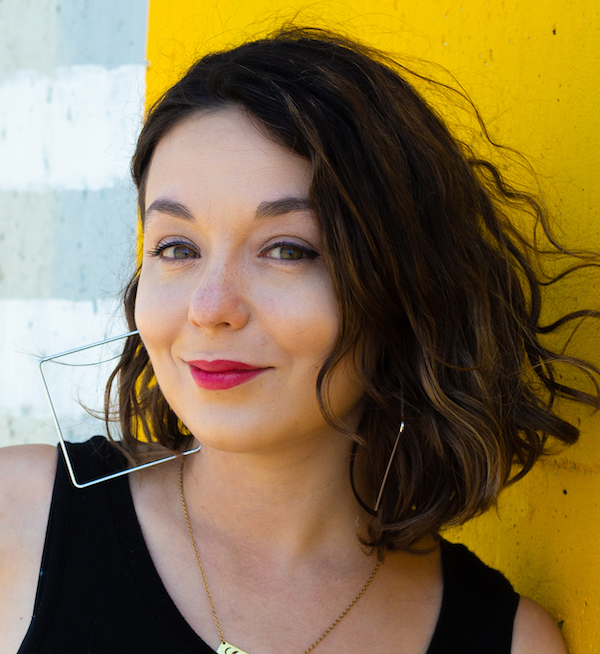
- Details
- By Elyse Wild
For ten days, highways threading through the Western United States have carried the roaring song of motorcycles ridden by Native women on a sacred journey.
On Sunday, the Medicine Wheel Riders finished their 2,211-mile ride at the annual motorcycle rally in Sturgis, S.D., completing a trip that charted the shape of a medicine wheel, a symbol in many Native American tribes representing the dimensions of health and life.
Bright, multi-colored ribbons trailed their motorcycles, fluttering in the heat and wind, each bearing the name of a Missing or Murdered Indigenous Person (MMIP).
The fifth annual Medicine Wheel Ride began on Friday, July 26 at the Chumash Reservation in Southern California and concluded Sunday at the legendary Sturgis Motorcycle Rally, which draws some half-million bikers in early August each year.
The Medicine Wheel Riders say their goal is to raise awareness and promote the healing of those most impacted by the MMIP crisis, which has been called an epidemic, given rise to a federal commission, and sent waves of grief through Native communities across the country.
Lisa Rivera (Chichimeca and Yaqui) describes the Medicine Wheel Ride as “a prayer.”
“We want to bring medicine, we want to bring healing, we want to offer that,” Rivera told Native News Online. “It’s a prayer, it’s a journey. In this process, we are still being healed. Sometimes it’s really hard, but in the same sense, it’s something you’ve got to keep doing.”
The MMIP crisis is prevalent across the country, with Indigenous peoples being murdered at a rate ten times the national average. Homicide is one of the leading causes of death for Native women. While the Bureau of Indian Affairs estimates there are 4,200 unsolved MMIP cases, the actual number is likely higher, Native advocates say.
Advocates and lawmakers have identified multiple drivers of the MMIP crisis: egregiously underfunded tribal law enforcement; jurisdictional confusion between tribal, local, state police and the BIA; exclusion of Indigenous people in data; and underwhelming media coverage.
Often, Native families whose loved ones have gone missing or were found murdered report a lack of police response; unresolved cases closed without sufficient investigation, and being left to conduct their own investigations while grappling with profound grief.
Rivera, Corrine Tuma (Diné) and Luvy Yonnie (Diné) had never met each other when they convened in April 2019 with half-a-dozen other Native Women riders — including Medicine Wheel Ride co-founder Lynette Red Cloud Roberts — in Albuquerque, N.M. for the first Medicine Wheel Ride.
The three women lived thousands of miles apart — Rivera in Hawaii, Tuma on the Wind River Reservation in Wyoming, and Yonnie in Arizona.
“We didn’t know each other from anywhere until we met face-to-face that day,” Yonnie said.
That first year, riders rode from all four directions represented on the medicine wheel — North, South, East and West — to Topeka, Kan., completing the circle.
“We didn’t know what the outcome would be, but it was amazing,” Yonnie said. “From there we said, ‘We have got to continue to do this.’”
The next year and each year after, the ride drew hundreds of riders to nearby Bear Butte — or “Mato Paha” in the Lakota language — for the final leg of the ride. Bear Butte is a revered sacred ground for ceremony and prayer for many Native American tribes since time immemorial.
“Riding down Bear Butte with a long line of 200 bikers behind you, it brings tears and chills,”
Yonnie said. “It’s very powerful, indescribable.”
Many of the riders’ lives have been touched directly by the MMIP crisis. Tuma works at the tribal casino on the Wind River reservation in Wyoming, where Native American people make up about 3.5% of the state’s population, but represent 15% of the missing persons recorded in the state’s National Crime Information Center. She recalls the silence that suspended the cacophony of the casino floor the day when a Native co-worker’s daughter, Jocelyn Wagon, was found murdered in January 2019.
“It was so quiet,” Tuma said. “No one talked. Everyone felt the hurt (throughout) the whole casino.”
Less than a year later, the community was again stunned when Wagon’s sister, Jade, was found murdered.
“I carry those girls with me,” Tuma said. “I ride for those two girls. I ride for all of the others whose hurt I feel.”
Rivera’s great-grandmother was found hanged in Mexico; another family member was found dead in a canal. It’s been three years since Yonnie’s son was found dead in the Arizona desert.
Yonnie said she has a hard time speaking publicly about what happened to him.
“There are a lot of whys and no answers,” she said. “I understand each of us going through the same thing. I hold them all very dear to my heart.”
Growing up, Yannie rode dirtbikes and ATVs. She dreamed of having a red Harley Davidson Motorcycle that she planned to name “Rosie.” Now, she has that Harley, but it’s gray and named “Pony.” Yonnie is the group’s eagle staff carrier, a responsibility and honor often given to protectors and advocates of their community.
Throughout the ten-day ride, the women stop at different tribal communities along the way, accepting ribbons to tie to their bikes from families who have lost loved ones to the crisis.
Each ribbon is different, with a name and color or symbol representing the lost relative. If they want to, families tie their loved one's ribbons onto a rider's bike at the outset of the ride and untie them when the ride concludes.
During one ride, Rivera met a young girl who wanted to tie a ribbon onto her bike to honor her mother. Rivera let her sit on her motorcycle and rev the engine.
"I gave her a little smile and as much as I watched her pain and sadness when she throttled it, it was powerful and there were mixed emotions that came with it," Rivera said. "And that is how the ride is."
Tribal communities and organizations along the route embrace the riders and offer reprieve from the grind of the pavement and the elements, which can take a toll after hours of riding for days in a row.
“Hitting the pavement, (dealing with) the elements, working with each other — that is the work,” Tuma said. “Many communities along the way jump up and say, “How can we help?’”
This year, several of the stops included a screening of a short documentary about the Medicine Wheel Ride called “We Ride For Her,” directed by Prairie Rose Seminole and Katrina Lillian Sorento.
Tuma’s voice is full of emotion as describes the last leg of the 10-day, 2,000+ mile journey: riding down the sacred Bear Butte mountain, the air swelling with the powerful tension emanating from the riders.
“You can feel the presence of the Creator,” she said. “You know he’s listening. He could hear us as we (could) hear our procession of bikes. That mountain is a sacred place, and you can just feel that sacred blessing.”
More Stories Like This
BREAKING: Feds Reverse $2B in Cuts to Addiction, Mental Health; Native Programs RestoredTrump Administration Cuts End Five Indigenous Health Programs at Johns Hopkins
Navajo MMDR Task Force Addresses Gaps in Missing Persons Cases, Strengthens Alerts
Tribe Sues IHS Over Rejected Opioid Treatment Facility as Natives See Highest Overdose Rates
House Passes Bill to Extend ACA Subsidies for 3 Years


